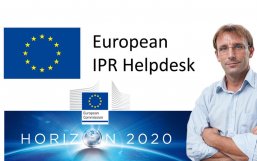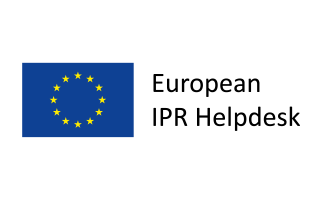Why is strategic IP management important for successful Horizon 2020 projects?
Eurice CEO Jörg Scherer has been interviewed by the Center for Technology Transfer Belgrade
As part of the European IPR Helpdesk training team, Eurice CEO Jörg Scherer joined the 2nd Belgrade Horizon 2020 Fair organised by the Center for Technology Transfer of the University of Belgrade. Besides providing a training session on Impact & Exploitation in Horizon 2020 project proposals, he gave an interview which has been translated into Serbian.
The training session has been recorded and is available on YouTube.
Please find the full English version of the interview here:
Intellectual Property (IP) management is an important part of Horizon 2020 projects. The number of project proposals that are being rejected due to insufficiently elaborated IP strategy is increasing. That is why we talked to Mr. Jörg Scherer, Chief Executive Officer of Eurice and Head of Training Activities of the European IPR Helpdesk, the official IP service initiative of the European Commission for researchers and SMEs participating in Horizon 2020 activities. Mr Scherer has an outstanding experience in the coordination of EU-funded research and innovation projects and his answers can be helpful if you are planning to write a H2020 project proposal.
Why is it important to consider IP and exploitation management in H2020?
JS: Paving the route to successful exploitation, intellectual property (IP) takes an essential role in the entire life cycle of R&D projects funded through Horizon 2020, the framework programme of the European Union (EU) for research and innovation for the period 2014-2020. With Horizon 2020, the EU aims at strengthening the European scientific and technological base and fostering benefits for society as well as better exploitation of the economic and industrial potential of policies of innovation, research and technological development. In fact, it is essential that the public resources and efforts used in research are converted into socio-economic benefits to the EU. For this reason Horizon 2020 establishes commitments from the participants in terms of exploitation of the projects’ results, including their protection through IP. Proper IP management should therefore be carefully considered from the very beginning of a project and is subject to evaluation criteria in the selection of proposals to be retained for EC funding. Major issues to be considered in this context are:
- How will results be protected? How will Joint Ownership be treated?
- How will the exchange of existing knowledge and know-how (i.e. "background") and results among partners and external stakeholders be managed? What are the best conditions to grant access rights?
- What are the best and most viable routes for exploitation of Horizon 2020 results?
What is Innovation Management and why is it important for H2020?
JS: Innovation Management describes the whole process from the creation of new ideas to the generation of impact – on different levels and not limited to business values. Research impact is a positive and demonstrable effect on society, including economy. Horizon 2020 is an output-oriented and flexible programme to develop creative solutions to incorporate intellectual assets into proper exploitation strategies. More than any of the former EU RTD framework programme initiatives it is calling for ideas and strategies to identify proper exploitation routes. There are great opportunities and there are not many limits to design the most suitable exploitation strategy at consortium and/or individual participant level.
Exploitation channels may encompass a wide range of different paths to bring research results to the marketplace such as:
- Improving existing/developing new products and services to be more competitive in existing and/or emerging new markets,
- Creating new businesses for further exploitation, i.e. Spin-offs or Joint Ventures among project partners or involving third parties outside of the project,
- Taking advantage of licensing opportunities by negotiating the right type of licence to be granted, e.g. exclusive, non-exclusive or sole licence, and whether it should be limited by the field of use and/or territory. By nature, licensing is a viable and the most common approach to create business opportunities out of research results,
- Using project outcomes for further research and teaching activities.
What is the value of IP analysis (i.e. state-of-the-art analysis, patent search, etc.) within Horizon 2020?
JS: Aiming to maximise the societal and economic impact of research and innovation projects, participants in today’s R&I funding schemes are increasingly called upon to provide sound and evidence-based strategies for exploitation, IP and innovation management. This holds particularly true for the EU's Horizon 2020 programme. The IP analysis of the project background and upcoming results is a key step towards safeguarding scientific and economic impact of a Horizon 2020 projects. Participants in Horizon 2020 projects are asked to demonstrate the innovation potential and capacity of their project, and to show how their activities and expected results will go beyond the "State of the Art".
The detailed analysis of already existing or future IP(R) held inside and outside the project consortium is the basis for any professional exploitation strategy: Who might be interested in the IPR (i.e. patents) held by the consortium? Are there other Intellectual Property Rights closely connected to the ones held by the consortium? Who would be interested in licensing project results?
Consortium partner must seek to ensure that their exploitation strategies do not infringe on IP (patent) rights of others. Patent litigation can be an expensive, uncertain and risky affair and, as the saying goes, prevention is better than cure. Whenever a project partner is planning to develop and launch a new product, a major risk, particularly in technology sectors where there is extensive patenting, is that commercialisation may be blocked by a competitor who holds a patent for a technology incorporated within that product. This is why Horizon 2020 projects offers the opportunity, at an early stage of technology development, to analyse the "freedom to operate," i.e. to ensure that the commercial production, marketing and use of their new product, process or service does not infringe the IP rights of others.
Timing: When do communication, dissemination and exploitation activities become relevant?
JS: The strategic planning of communication actions together with appropriate dissemination and exploitation measures begins during the proposal stage of a project. Once it is running, the communication actions will accompany the R&I work of the project throughout its duration, while activities related to the dissemination and exploitation of results often continue even after it has come to a close. Nevertheless, it is advisable to already consider exploitation aspects during the proposal stage.
Relevant project outputs result throughout the course of project – not only towards the end – therefore it is essential to closely capture, monitor and manage results (including the IP that goes along with it) over the entire lifetime of the project and adjust communication activities, as well as dissemination and exploitation plans accordingly. Additionally, yet unknown results which might develop during the course of the project should be closely monitored and captured at various stages during the project to foster exploitation and further application in various fields.
Even though dissemination and exploitation of results are relevant during the project, these activities usually gain more momentum towards the end of the project when the bulk of expected outcomes typically emerge. Consequently, there has to be a viable plan in place to address what happens after the project has come to a close – even more so, since project partners are contractually obligated to use their best efforts to exploit the results 4 years after project completion. Dissemination and exploitation measures thus remain relevant beyond the project’s end: results should continue to be publicised, ideally creating an increasing awareness and interest amongst potential users, which in turn fuels further exploitation of results.
Why is market search needed when writing a project proposal? What steps should be taken to secure thorough market search?
JS: Usually, at proposal stage, you outline an initial exploitation plan through a characterization/mapping of potential valuable and exploitable results, i.e. identify different types of results and their potential user groups – on partner and/or consortium level. In a next step you describe your plans on how to get the expected innovations 'out of the lab' and into (or at least closer to) the market by identifying possible, most appropriate exploitation routes for the expected key exploitable results corresponding to the nature of the different results and their target users.
Describe whether innovations will be deployed within partner business activities or newly introduced to the market? Will new markets be created? Choose concrete exploitation measures to ensure that results will meet real needs and thus will be taken up. What are the relevant steps within the project lifetime and beyond?
Already at proposal stage, you should briefly describe the main target groups/customers including their needs, expectations and potential benefits and provide details about the size and readiness of the market (including time plan, risks, barriers) to deploy the innovation. Use strategic intelligence (such as patent analysis tools) to identify and assess competing technologies, market competitors, future trends, etc.
Last but not least, do not forget to reflect on potential barriers/obstacles, and how to overcome them and identify any further crucial conditions for market deployment, i.e. financial investments, regulatory affairs, business development, marketing.
How to make strategies and plans to capture, manage and exploit results of H2020 projects? What are the most common mistakes regarding this aspect when writing a project proposal?
JS: Make sure that you design and implement adequate internal structures safeguarding effective knowledge, IP and innovation management helping create, capture and manage research results. From the very beginning of project planning, raise awareness among all partners of good research practice and the importance of IP management (incl. confidentiality, ownership, access rights, responsibilities). Establish procedures to recognise, capture and characterise project outputs (e.g. notification of partners of any publication or disclosure).
Assess, balance and moderate the possibly varying exploitation interests of project partners (e.g. through exploitation or innovation questionnaires) and come up with a jointly agreed strategy that responds to the overall reason for the project: to jointly address specific challenges and expected impacts – and not partners individual interests. Systematically plan, prepare and implement appropriate activities to identify, assess and prioritize key exploitable results (e.g. exploitation workshops). Establish proper arrangements to ensure freedom-to-operate with project results; i.e. pre-publications reviews, checking potential third party infringements.
How does research impact relate to communication, dissemination and exploitation activities within Horizon 2020 projects? What are common mistakes when drafting plans for outreach activities?
JS: As I said before, excellent science needs effective communication. Bringing research and its outcomes to the attention of non-scientific audiences, scientific peers, potential business partners or policy-makers fosters collaboration and innovation. Strategic outreach activities help explain the wider societal relevance of science, build support for future research and innovation funding, ensure uptake of results within the scientific community, and open up potential business opportunities for novel products or services. In sum, it helps increase the impact of research and innovation in multiple ways.
Therefore, participants in Horizon 2020 projects are required to promote their activities and results. In this context the terms 'Communication', 'Dissemination' and 'Exploitation' are widely used to refer to a number of actions, strategies, approaches and notions in general on how research teams in a Horizon 2020 project can fulfil this commitment.
Many times when writing a proposal, project teams consider 'Communication', 'Dissemination' and 'Exploitation' abstract measures that are only marginally linked to their actual (scientific) work. Or they are under the impression that scientific publications alone are sufficient to communicate their work to an audience that matters. Any activities concerning potential exploitation or communication to the broader public are considered only as "pro forma" – they have to be mentioned in the proposal, but have no added value. Consequently the activities planned in these areas often result in non-strategic, ad hoc efforts lacking clearly defined objectives and targets.
Given the increased focus on impact in the Horizon 2020 programme and the importance attached to activities that help demonstrate and maximise the societal and economic impact of Research & Innovation (R&I) funding, effective plans for communication, dissemination and exploitation are considered increasingly significant for successful project evaluation. Communication activities to promote the project itself and its success, alongside the dissemination and exploitation of results should thus be key components of every Horizon 2020 project.
Obviously, the extent to which projects define and balance their approach towards communication, dissemination and exploitation activities must vary and a one-fits-all solution is neither reasonable nor desirable.
What would be your crucial advice to all applicants for H2020?
JS: Impact plays a key role in the evaluation of Horizon 2020 proposals. In Horizon 2020 research and Innovation Actions impact forms a third of the total evaluation score along with excellence and quality and efficiency of the implementation. Even scientifically brilliant proposals will fail if the impact section is not excellent. Therefore, assess objectively whether your consortium can deliver the expected impact – don’t try if you can’t.
If you think that your proposal can address the expected impact listed in the call topic description, make sure that you identify and plan all necessary activities to achieve the expected impact through effective communication, dissemination and exploitation measures (including proper IP management). It has to be clear that project teams aiming for a successful Horizon 2020 project need to reflect and address communication, dissemination and exploitation through an integrated approach that strategically targets these measures, and which is closely tied to the project's work plan.
Interviewed: Mr Jörg Scherer, Chief Executive Officer of Eurice
Text adapted: Mr Vuk Suša Stupar, Center for Technology Transfer Belgrade



